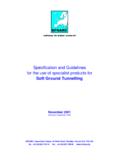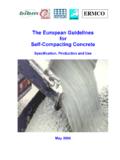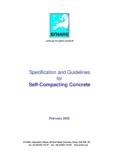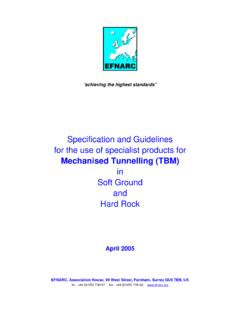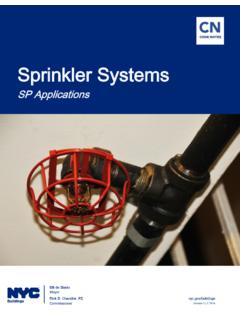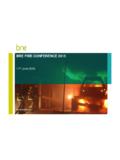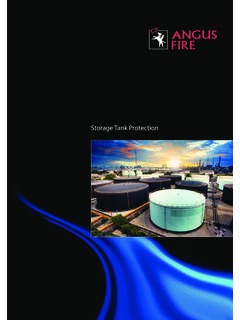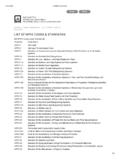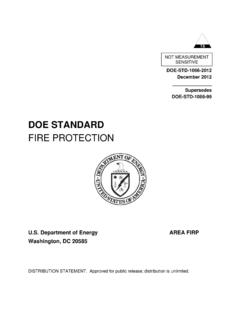Transcription of Specification and Guidelines for Testing of Passive …
1 'achieving the highest standards' Specification and Guidelines for Testing of Passive fire Protection for Concrete Tunnels Linings March 2006 EFNARC Contents 1. Introduction and 2. 3. 4. fire 5. Test 6. Samples ..5 7. Concrete for test 8. 9. Sample preparation and 10. 11. fire test 12. Test 13 Further 14 Test 15 16 Appendix A: Examples of fire Load 17 Annex B: fire Load maximum deviation calculation and 132F r3, 24/02/06. 1 1. Introduction and Definition Following a succession of major tunnel fires across Europe, the need for effective fire protection for the structural concrete lining has become a matter of priority for both new and existing tunnels.
2 This guideline covers the assessment of Passive fire protection systems. Passive fire protection forms a permanent part of the tunnel and does not require external activation in the event of a fire . These Guidelines do not cover the assessment of active fire protection such as sprinkler systems. The role of Passive fire protection in tunnels is to: Minimise the rate of temperature rise within the concrete and structural steel reinforcement (if present) so that structural integrity is retained during and after the fire . To reduce or eliminate the risk of explosive spalling and loss of the concrete surface resulting from a build up of vapour pressure within the concrete.
3 Within the scope of these Guidelines , Passive fire protection of concrete for tunnel linings and members can be achieved by one of the following means: An applied protective coating or render. A preformed thermal barrier or board fixed to the concrete surface. Integral protection incorporated into the structural concrete, usually based on polypropylene fibres. Note that this system may require additional concrete thickness as some degradation of the concrete can occur. A number of proprietary Passive fire protection products and systems are available and these Guidelines provide a common test procedure for: Provision of standardised data from suppliers.
4 Initial product evaluation and selection by specifiers. Continued quality monitoring during a contract. Testing to these Guidelines is based on severe conditions; any deviation from the standard procedure must be reported and taken into account during risk assessment by site engineers for the contract. 2. Scope This document provides a Specification for the Testing of Passive fire protection systems for reinforced or un-reinforced concrete tunnel linings. It does not cover fire stops or fire protection for cables and installations. Neither does it provide information on the effects of aging on the protection system.
5 The aim of these Guidelines is to harmonize the test procedures and reporting within Europe. These Guidelines are not intended to form a basis for research work or scientific investigation into the effects of tunnel fires on concrete or the detailed effects of fire protection systems but reference is made to such work in the bibliography. These Guidelines are applicable to concrete structures where the protection is a spray applied coating, a surface fixed barrier or is integrally cast into the concrete. 132F r3, 24/02/06. 2 3. References EN 197-1: Cement Part 1: Composition, Specification and conformity criteria for common cements.
6 EN 206-1: Concrete Part 1: Specification , performance, production and conformity. EN 1363-1: fire resistance tests Part 1: General requirements. EN 1363-2: fire resistance tests Part 2: Alternative and additional procedures. EN 12390-1: Testing hardened concrete Part 1: Shapes, dimensions and other requirements of specimens and moulds. EN 12390-2: Testing hardened concrete Part 2: Making and curing specimens for strength tests. EN 12390-3: Testing hardened concrete Part 3: Compressive strength of test specimens. EN 12390-4: Testing hardened concrete Part 4: Compressive strength Specification for Testing machines.
7 ENV 13381: Test methods for determining the contribution to the fire resistance of structural members. 4. fire Loading fire Loading can be defined as: a specified temperature: time relationship for a concrete member subjected to a fire . Within the scope of these Guidelines , the temperature is measured in a furnace at a distance of 100 mm from the face of the member. The fire Loading selected for Testing and the performance required from the Passive fire protection system will depend on factors relevant to a specific tunnel. It should be based on a risk assessment in the event of a worst case fire , taking into account the situation during the fire and also the subsequent safety and likely economic effects following the fire .
8 Relevant factors include: The type/construction, location, structural loads and intended use of the tunnel. The potential severity of a fire , the evacuation and fire control system. The tunnel remediation procedures envisaged following a sever fire . The economic and social consequences of prolonged closure of the tunnel Taking these factors into account together with published data on tunnel fires, estimates can be made for the potential temperatures that will be reached in the tunnel over time and a fire load curve derived. As well as the maximum temperature and duration of the fire , factors including the cooling period and the use of water to induce rapid cooling must be considered as these can have a significant impact on the structural integrity of the concrete.
9 Guideline fire load curve The following fire load curve should be used with these Guidelines . Other standard fire load curves are also given in clause 132F r3, 24/02/06. 3 Time after Ignition, min Target Furnace Temperature oC Maximum Deviation % 0 < 50* 5 >1150 10 1200 < 10 min =15% 30 1300 < 30 min =10% 60 1350 90 1300 120 1200 >
10 30 min = 5% * Not applicable to the small scale test furnace. The Furnace should be shut down at 120 minutes after the start of the test but the sample should be left for a minimum of 1 hour before being moved. Temperature measurements in the sample should be continued and reported until the temperature of the thermocouples embedded in the concrete and nearest the furnace exposed face fall to below 200 oC or if cooling is slow, up to 240 minutes after the start of the test. Note: controlled cooling is important as it may affect the condition of the concrete during post test assessment. General comments on the temperature time curve: After 5 minutes the maximum deviation of the temperature time curve from the target value shall be within the requirements of EN 1363-2 (hydrocarbon curve).


